
Shrubs Around Las Vegas, Vegetation Around Las Vegas
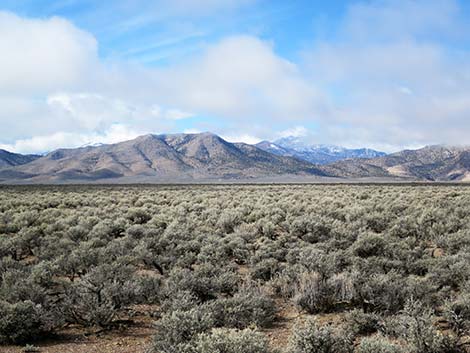 |
General: Sagebrush (Artemisia) is a stout, dense, upright shrub with blue-gray leaves and 3- to 6-inch tall flower stalks that stand up above the foliage. The flower stalks persist long after the flowers are gone. The aromatic leaves are narrow and wedge-shaped with notches in the blunt tip, and usually densely hairy. Evergreen. Individually, the flowers are small, but together they form several blue spikes of color above the plant during spring. There are about 300 species in the genus Artemisia, but fortunately, only 21-31 species occur in Nevada, depending on how you count them. Sagebrush usually is an uncommon component of higher elevation slopes in the mountains around Las Vegas, but it is the dominant species north of Las Vegas, covering thousands of square miles of mountains and valleys in the Great Basin Desert. Around Las Vegas, sagebrush occurs in higher-elevations canyons, bajadas, and mountain slopes from the Upper Sonoran (Mojave Desert Scrub and Pinyon-Juniper Woodland), Transition (Yellow Pine Forest), Canadian (Pine-Fir Forest), and Hudsonian (Bristlecone Forest) life zones. In some places in the Spring Mountains, sagebrush forms prairies where trees are absent. |
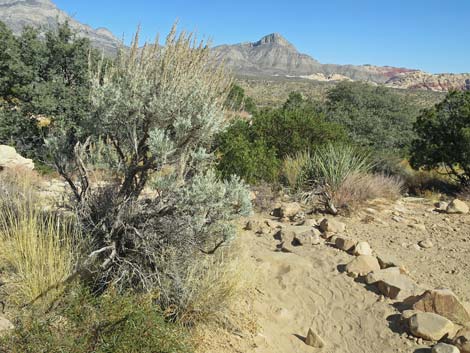 |
Family: Sunflower (Asteraceae). Other names: Plant Form: dense, upright shrub. Height: 6 inches to 6 feet, depending on species; usually 1-3 feet around Las Vegas. Bark: gray-brown, shaggy. Stems: stout and woody; grows from a woody base. |
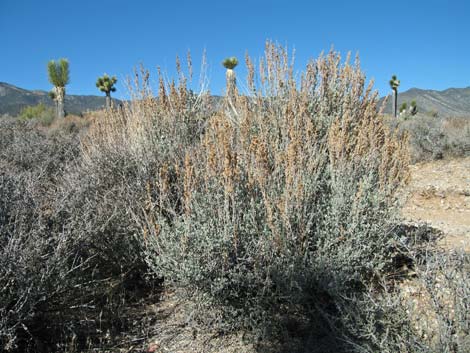 Flower stalks during winter. |
Leaves: Blue-gray, wedge-shaped to about 1-inch long by 1/4 inch wide), usually two notches in the blunt tip, aromatic, usually densely hairy. Flowers: Tiny, blue flowers on a branching spike (panicle). Individual flowers are obscure, but the mass appears blue. Seeds: Tiny (< 2 mm), oblong. Habitat: Around Las Vegas, dry, well-drained sandy, gravelly, and rocky soils on upper bajadas, ridges, canyon, and mountain slopes. Elevation: 4,500 to 10,000 feet. Distribution: Various species occur throughout the northern hemisphere. Comments: |
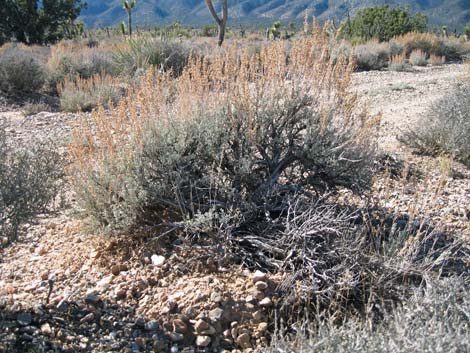 |
Big Sagebrush (Artemisia tridentata). A fairly large, upright, brushy shrub with upright stems and blue green leaves divided into three lobes at the tip. Flowerheads are small and borne along the upper stem.
Big Sagebrush is one of the dominant shrub species in the Great Basin Desert, and it extends into the Mojave Desert at higher elevations and is a fairly common component of mountain communities in drier areas in the Upper Sonoran (Pinyon-Juniper Woodland), Transition (Yellow Pine), and Canadian (Pine-Fir Forest) life zones. There are three subspecies of Big Sagebrush. Wyoming Big Sagebrush is our standard sagebrush of big, open valleys with a rounded top. Basin Big Sagebrush is a very tall plant of fertile soils with a distinct trunk, and Mountain Big Sagebrush of higher elevations is smaller with a flattish top. |
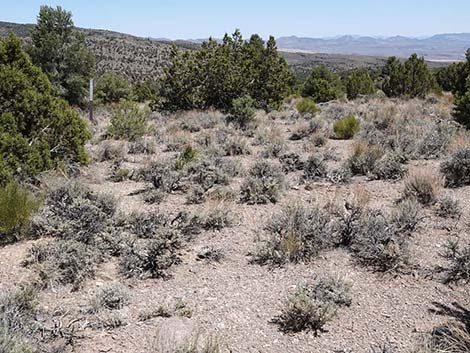 |
Black Sagebrush (Artemisia nova). A low-growing, upright, brushy shrub with upright stems and gray-green leaves. Basal leaves are divided into three lobes at the tip, while upper leaves often are entire. Plant crown is uneven (not flat topped). Leaves with numerous dark glands on the surface, sticky to touch when mashed between fingers. Flowerheads composed of disk flowers only (no "petals" on this sunflower). Old flower stalks brown, persistent on the plant.
Flowerheads are small and borne along the upper stem. Also on the flowering stems are ephemeral leaves, and these leaves are entire (no lobes). |
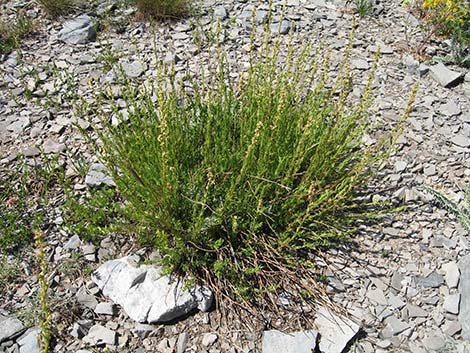 |
Michaux's Sagebrush (Artemisia michauxiana). A high-elevation, fairly low-growing, brushy shrub with green, upright stems and highly dissected leaves. Flowerheads are small and borne along the upper stem. |
Note: All distances, elevations, and other facts are approximate. Names generally follow the USDA database.
![]() ; Last updated 250706
; Last updated 250706
| All Shrubs | Plant Species Index | Glossary | Copyright, Conditions, Disclaimer | Home |